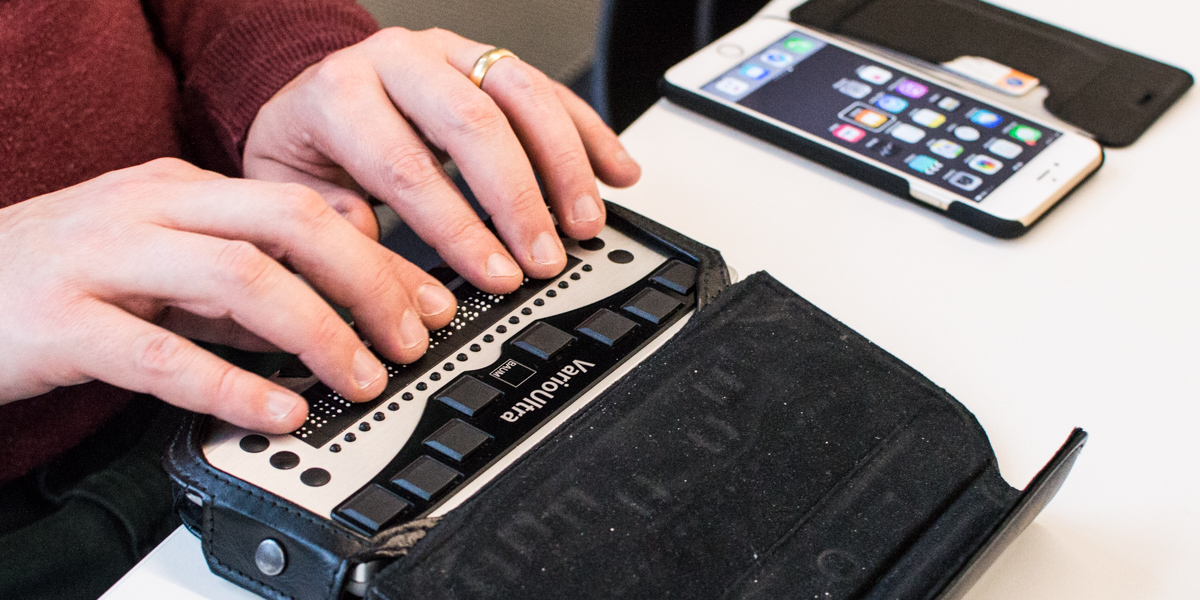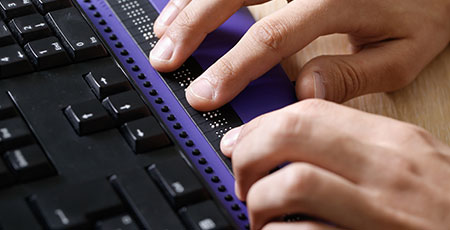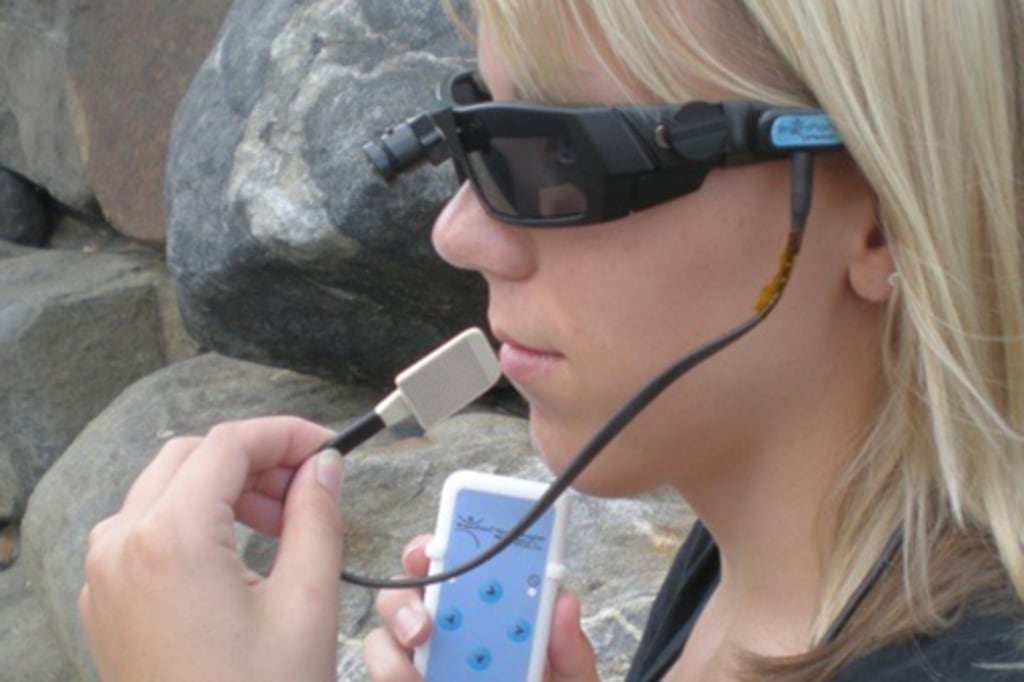Smart Glasses for the Visually Impaired: Innovations in Vision Support
Smart Glasses for the Visually Impaired: Innovations in Vision Support
Blog Article
Discover Cutting-edge Devices Created for the Visually Impaired
The advancement of ingenious tools for the visually damaged represents a significant development in ease of access and independence. Technologies such as clever glasses with AI abilities and mobile applications developed to provide acoustic descriptions are reshaping day-to-day experiences for individuals. Additionally, wearable tools that utilize haptic responses boost ecological recognition, while modern-day Braille developments use new means to engage with text. As these tools remain to develop, their impact on the lives of those with aesthetic impairments raises vital concerns concerning the future of inclusivity and autonomy in numerous aspects of life. What exists ahead in this technical landscape?
Smart Glasses for Navigation

Smart glasses made for navigation are transforming the means aesthetically impaired individuals connect with their environment. These innovative tools utilize a mix of camera modern technology, expert system, and auditory responses to offer real-time information concerning environments. By utilizing challenge detection systems, smart glasses can alert individuals to possible threats, enabling more secure mobility in both strange and acquainted setups.
The combination of GPS technology additionally enhances navigation capabilities, allowing users to get auditory instructions as they relocate. This hands-free strategy not only fosters independence however additionally encourages visually impaired people to browse city landscapes with enhanced self-confidence. In addition, numerous wise glasses are outfitted with features that recognize spots and street indications, giving contextual information that enhances the customer experience.
Moreover, the growth of these devices is continually advancing, with business functioning to enhance the precision of object acknowledgment and increase the variety of navigational features. As wise glasses end up being a lot more obtainable and budget friendly, they hold the potential to significantly transform day-to-day live for visually impaired users. Eventually, these ingenious devices represent an important action towards inclusivity, offering enhanced mobility and a greater feeling of freedom for individuals browsing the globe around them.

Mobile Application for Daily Living
Exactly how can mobile applications enhance the lives of aesthetically damaged people? Mobile apps are reinventing the means aesthetically damaged customers browse their settings, manage daily jobs, and accessibility info. These applications provide crucial support with numerous performances, fostering freedom and enhancing high quality of life.
A number of ingenious mobile applications are developed specifically for day-to-day living. Applications like Be My Eyes connect visually damaged customers with sighted volunteers via video calls, allowing them to receive real-time help with jobs such as reviewing labels or browsing unfamiliar areas. Likewise, Seeing AI, created by Microsoft, utilizes expert system to define environments, read message, and identify objects, successfully transforming a mobile phone into a powerful device for daily help.
Furthermore, navigating applications tailored for the visually damaged, such as Aira and BlindSquare, offer audio-based directions and environmental details, enabling individuals to traverse their surroundings safely and with confidence. Beyond navigation and prompt assistance, mobile apps additionally sustain company and job management, with features that assist individuals set suggestions, produce order of business, and track appointments. In recap, mobile applications act as indispensable sources, empowering visually damaged individuals to lead more independent and fulfilling lives.
Wearable Technologies for Aid
Empowerment with technology is increasingly evident in the world of wearable tools designed to aid visually impaired people. These cutting-edge tools incorporate effortlessly right into daily life, enhancing navigation and giving important comments to individuals. Smart glasses geared up with video cameras can acknowledge faces and review message aloud, enabling individuals to communicate even more confidently in specialist and social setups.
Another significant improvement is the use of haptic responses systems in wearable tools. These systems use resonances or various other tactile signals to communicate info concerning the customer's environment, such as challenges or changes in surface, enhancing flexibility and security. Wearable technologies likewise consist of wristbands that attach to smart devices, signaling customers to alerts through refined vibrations, hence improving connection without dependence on aesthetic signs.
As these innovations remain to progress, they are not just improving independence for visually damaged people but likewise fostering a better sense of incorporation in society. see post By connecting the void between challenges dealt with in day-to-day living and the capacity for autonomy, wearable innovations act as essential tools in the pursuit for equal rights and empowerment for those with aesthetic problems.
Audio Description Devices
Sound description tools play a critical duty in improving availability for visually damaged individuals, giving them with the capacity to involve with visual media. Screen readers for the blind. These tools supply narrated descriptions of key aesthetic aspects in films, television shows, and live performances, making sure that individuals can totally understand the context and emotions conveyed through visuals
Audio summary can be integrated right into various platforms, consisting of streaming solutions, cinema screenings, and live theater. Many prominent streaming solutions now consist of audio summary as an availability feature, permitting customers to choose it conveniently. Along with conventional media, specialized applications also exist, providing audio descriptions for art exhibitions, galleries, and other cultural occasions.
The performance of audio summary rests on the ability of the storytellers, that should share visual details succinctly without diminishing the original audio. Advancements in this area are likewise leading the way for even more individualized experiences, where users can adjust the degree of detail and pacing according to their choices.
Braille Innovations and Instruments
Braille advancements and tools have actually substantially changed the way visually impaired individuals connect with text and information. Modern advancements have actually led to the development of functional tools that improve proficiency and self-reliance amongst users.
Furthermore, mobile Braille notetakers incorporate typical Braille input with contemporary functionalities, promoting note-taking, scheduling, and paper editing on the go. Assistive technology for the blind. These small devices often include text-to-speech capacities, linking the void in between Braille visit their website and acoustic info
Additionally, innovative Braille printers have actually emerged, enabling users to create Braille labels, files, and academic products efficiently. This accessibility promotes better involvement in expert and instructional atmospheres, inevitably advertising inclusivity.
Additionally, study into smart Braille modern technologies remains to expand. Devices that incorporate artificial knowledge are being explored to give real-time navigation assistance and contextual info, boosting the individual experience in diverse settings. Generally, these innovations reflect a commitment to empowering visually impaired individuals with technology, guaranteeing they can conveniently access and involve with the globe around them.

Final Thought
The advancement of ingenious devices for the visually impaired substantially improves self-reliance and quality of life. Smart glasses, mobile applications, wearable innovations, audio description devices, and Braille advancements collectively empower individuals by offering important navigation aid, ecological awareness, and improved analysis experiences. These innovations not just foster higher inclusion however likewise advertise freedom in daily activities, eventually contributing to a more fair and easily accessible culture for aesthetically damaged individuals. Proceeded development in this area holds guarantee for further enhancements.
As smart glasses end up inexpensive prescription glasses being extra obtainable and affordable, they hold the potential to considerably change everyday life for visually impaired customers. Mobile applications are reinventing the means aesthetically damaged users browse their atmospheres, take care of everyday jobs, and accessibility information. Applications like Be My Eyes link aesthetically damaged users with sighted volunteers by means of video clip calls, permitting them to get real-time assistance with tasks such as reading labels or browsing unfamiliar rooms.Furthermore, navigating applications customized for the visually impaired, such as Aira and BlindSquare, offer audio-based instructions and environmental info, allowing users to traverse their environments securely and confidently.The development of cutting-edge devices for the visually impaired substantially boosts independence and quality of life.
Report this page